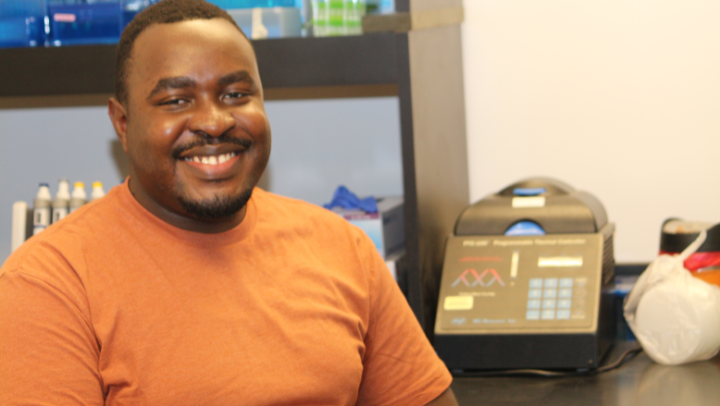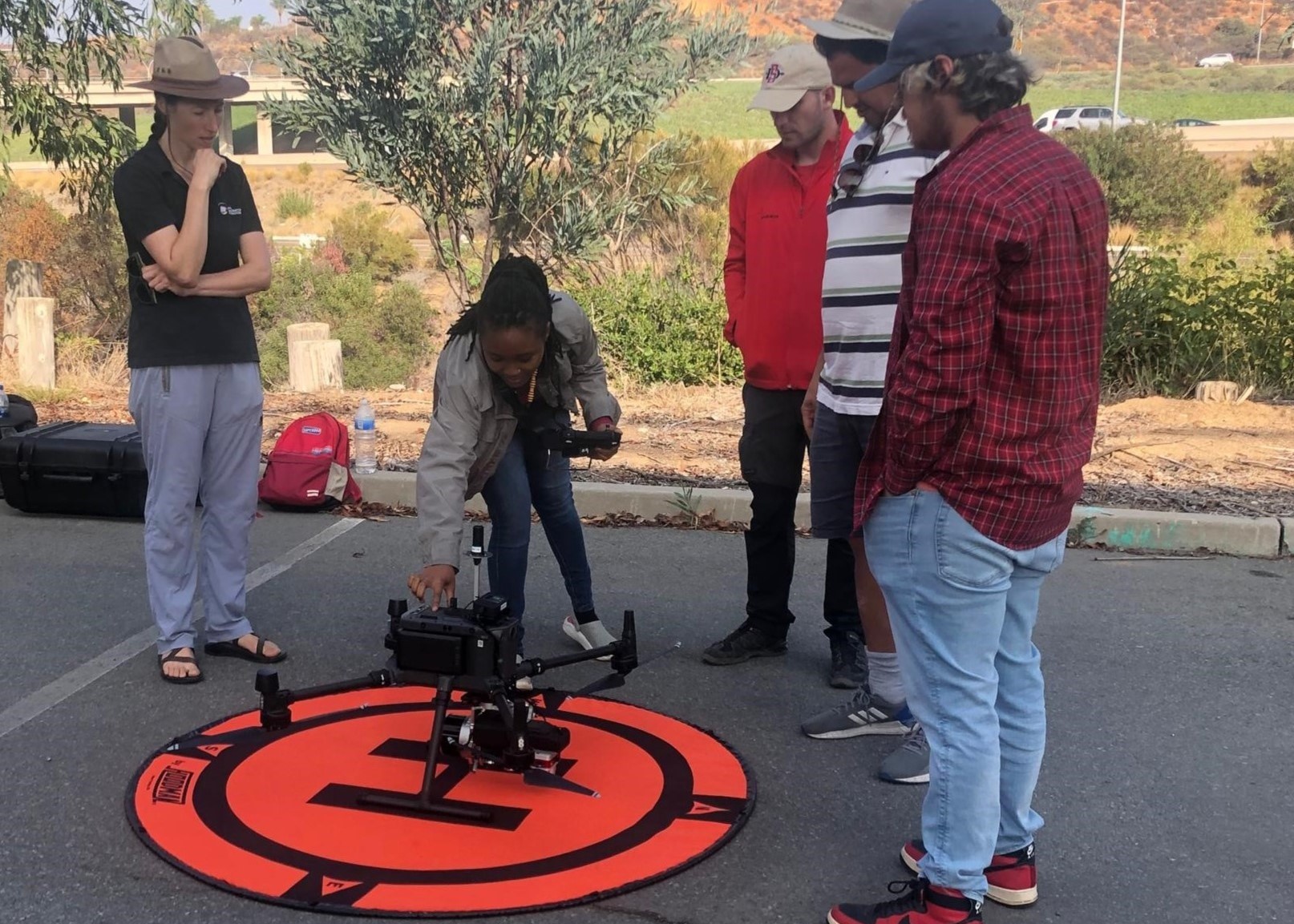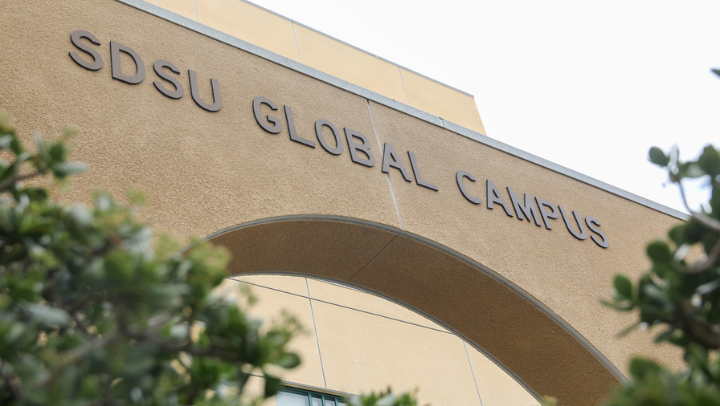SDSU’s research opportunities entice international students
Three graduate students from Africa highlight their research journey on the heels of the university achieving R1 status

When Trevor Mugoya began searching for graduate schools the Uganda native didn’t look for universities based on rankings or location.
Instead, he focused on colleges with research labs in his field and openings for master’s and Ph.D. students. “I wanted, from the beginning, to be part of the research structure as I was starting my program.”
After emailing professors around the world, Mugoya connected with San Diego State University Computational Evolutionary Biologist and lab head Arun Sethuraman. He was admitted to the Bioinformatics and Medical Informatics master’s program in the fall 2023.
SDSU's growing research opportunities attract not only homegrown scholars but also degree-seeking international students who bring diversity in perspectives and lived experiences to campus. Last month, SDSU joined a select group in the top 5% of higher education institutions to achieve R1 status, the highest research distinction given in the Carnegie Classification of Institutions of Higher Education
R1 shines a spotlight on high-quality research at SDSU. Here are three international students, all from Africa, pursuing research through masters’ and joint doctoral programs offered at SDSU.
Teasing out genetic traits
During his final undergraduate semester at Jomo Kenyatta University of Agriculture and Technology in Kenya, Mugoya took an introduction to bioinformatics class, which combined his major, biotechnology, with his longtime interest in computer science.
“This was a light bulb moment for me,” he said. “I realized then that this is something I really want to make a career out of, but I only had one class.”
After graduation, Mugoya landed an internship at Uganda Virus Research Institute, where he worked with computational tools to monitor insecticide resistance among mosquito populations as part of a malaria surveillance program.
Mugoya realized he needed to expand his skillset. That led him to SDSU. For his master’s program, he builds computational pipelines that tease out the signatures of structural variants in plant genomic data. These structural variants can drive plant characteristics, such as disease resistance, adaptation to environmental stressors and more.
Bioinformatics tools already exist to uncover structural variants, but plant genomes are often huge, with many duplicate or repeat sequence elements that make a comprehensive understanding of genomic variants hard to uncover.
“I am building a pipeline that has an ensemble of tools that will give a profile of structural variants in large plant genomic data,” he said. “While I’m focusing on plant data right now, in theory it can be applied to any kind of DNA sequencing data as well.”
After finishing his master’s, Mugoya aims to work in the field before deciding whether to pursue a doctorate.
Tracking trash from above
 Open the image full screen.
Open the image full screen.
This experience dovetailed with research at Trent Biggs’ Watershed Science Lab, which is probing the many ways land-based debris makes its way to the ocean. Jack reached out to Biggs after seeing an advertisement for SDSU, and following an interview, she enrolled in the Geographic Information Systems Master’s Program.
“There was a beautiful thing about San Diego State that interested me,” she said. “It has many female students and female scientists.” Biggs’s lab, she said, “was like a community of sisters.”
One of her projects involved working on a machine learning algorithm to pinpoint trash hotspots in the Mission Valley Preserve using high-resolution imagery from drones.
The algorithm not only spotlighted areas with heavy debris but also categorized the trash as plastic, fabric, metal, and so on. This mapping gave the project’s nonprofit partner, the San Diego River Park Foundation, a head start during volunteer clean-up events.
Jack also probed how well the algorithm identified debris from imagery shot using an expensive commercial drone versus imagery from more affordable consumer drones.
She earned her master’s in spring 2024 and now is enrolled in the SDSU/University of California Santa Barbara Joint Doctoral Program in Geography. She’s doing coursework for now but hopes to conduct research on the impact of wildfires on the atmosphere and climate of Southern Africa.
Modeling infectious diseases
Oluwatosin Jegede started his career as a medical doctor in Nigeria, but he pivoted to public health in hopes of making a difference in population-wide disease prevention. He worked on several public health programs while at the U.N. Office on Drugs and Crime, including a training effort that successfully prevented COVID-19 outbreaks in Nigerian custodial centers.
His primary interest, however, is public health interventions to prevent overdoses, HIV, hepatitis and other health maladies among people who use drugs and other high risk populations. He is building models to evaluate the impact and cost effectiveness of myriad public health initiatives.
That led him to the SDSU-University of California San Diego Global Health Joint Doctoral Program, where he is honing his expertise in modeling research under the mentorship of UCSD Professor Natasha Martin from the Division of Infectious Diseases and Global Public Health.
After two years of coursework at SDSU and UCSD, Jegede is in the preliminary stage of his doctoral research. It involves modeling and analysis in three areas: The contribution of fentanyl to overdoses among people who inject drugs in San Diego; the progress of HIV interventions among people who inject drugs in South Africa; and the cost effectiveness of hepatitis treatment among people who inject drugs in India, under the backdrop of using quantitative methods to provide data on how to improve health among people who inject drugs.
“So, three different nations, but in general it’s about harm reduction in people who inject drugs,” he said. “With the research, I will be bringing in ideas from the modeling to say, OK, if we implement this or that, here are the likely outcomes.”



